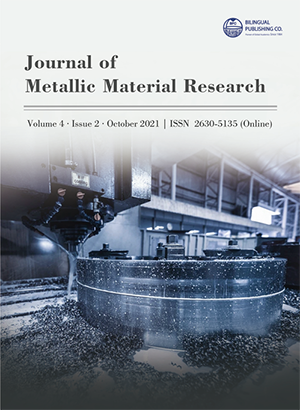-
186
-
167
-
143
-
112
-
103
Surface Tension of GaInSnBiZn Liquid High-entropy Alloy
DOI:
https://doi.org/10.30564/jmmr.v4i2.4091Abstract
As an emerging alloy material, high-entropy alloy has potential applications that distinguish it from traditional alloys due to its special physicochemical properties. In this work, a low melting point GaInSnBiZn high-entropy alloy was designed based on Miedema model, and its surface tension was measured by the continuous pendant-drop method. The results show that the intrinsic surface tension of GaInSnBiZn high-entropy alloy at 80 °C is 545±5 mN/m, and the surface tension of the liquid alloy is significantly reduced by the formation of surface oxide film. The surface tension of GaInSnBiZn high-entropy alloy was analyzed by using theoretical models (Guggenheim model, GSM (general solution) model and Butler model), and the thermodynamic characteristics of the surface tension formation were further verified by combining with thermodynamic calculations, among which the calculated results of Butler model were in good agreement with the experimental data. Meanwhile, it is found that the surface concentration of Bi in the alloy is much larger than the nominal concentration of its bulk phase, which contributes the most to the surface tension of the alloy, however, it contributes the least to the entropy of the alloy formation in combination with the Butler model.Keywords:
High-entropy alloy; Pendant-drop method; Thermodynamics; Formation entropyReferences
[1] Wang, X., Guo, R., Liu, J., 2019. Liquid metal based soft robotics: materials, designs, and applications. Advanced Materials Technologies. 4, 1800549.
[2] Zhao, X., Xu, S., Liu, J., 2017. Surface tension of liquid metal: role, mechanism and application. Frontiers in Energy. 11, 535-567.
[3] Joo, S.H., Kato, H., Jang, M.J., Moon, J., Kim, E.B., Hong, S.J., Kim, H.S., 2017. Structure and properties of ultrafine-grained CoCrFeMnNi high-entropy alloys produced by mechanical alloying and spark plasma sintering. Journal of Alloys and Compounds. 698, 591- 604.
[4] Zhang, Y., Zuo, T.T., Tang, Z., Gao, M.C., Dahmen, K.A., Liaw, P.K., Lu, Z.P., 2014. Microstructures and properties of high-entropy alloys. Progress in Materials Science. 61, 1-93.
[5] Ye, Y.X., Liu, C.Z., Wang, H., Nieh, T.G., 2018. Friction and wear behavior of a single-phase equiatomic TiZrHfNb high-entropy alloy studied using a nanoscratch technique. Acta Materialia. 147, 78-89.
[6] Yan, X., Zhang, Y., 2020. Functional properties and promising applications of high entropy alloys. Scripta Materialia. 187, 188-193.
[7] Fujii, H., Matsumoto, T., Nogi, K., 2000. Analysis of surface oscillation of droplet under microgravity for the determination of its surface tension. Acta Materialia. 48, 2933-2939.
[8] Przyborowski, M., Hibiya, T., Eguchi, M., Egry, I., 1995. Surface tension measurement of molten silicon by the oscillating drop method using electromagnetic levitation. Journal of Crystal Growth. 151, 60-65.
[9] Iida, T., Guthrie, R., 1988. The Physical Properties of Liquid Metals. UK: Oxford University Press.
[10] Ding, Y., Zeng, M., Fu, L., 2020. Surface chemistry of gallium-based liquid metals. Matter. 3, 1477-1506.
[11] Cui, Y., Ishihara, S., Liu, X., Shirong, Ohnuma, I., Kainuma, R., Ohtani, H., Ishida, K., 2002. Thermodynamic calculation of phase diagram in the Bi-In-Sb ternary system. Materials Transactions. 43, 1879-1886.
[12] Ren, L., Xu, X., Du, Y., Kalantar-Zadeh, K., Dou, S.X., 2020. Liquid metals and their hybrids as stimulus–responsive smart materials. Materials Today. 34, 92-114.
[13] Guggenheim, E.A., 1945. Statistical thermodynamics of the surface of a regular solution. Transactions of the Faraday Society. 41, 150-156.
[14] Yan, L., Zheng, S., Ding, G., Xu, G., Qiao, Z., 2007. Surface tension calculation of the Sn–Ga–In ternary alloy. Calphad. 31(1), 112-119.
[15] M’chaar, R., Sabbar, A., El Moudane, M., Ouerfelli, N., 2020. A survey of surface tension, molar volume and density for Sn–Ag–Cu–Bi–Sb quinary alloys as leadfree solders. Philosophical Magazine. 100, 1415-1438.




 Shirong Zhu
Shirong Zhu





